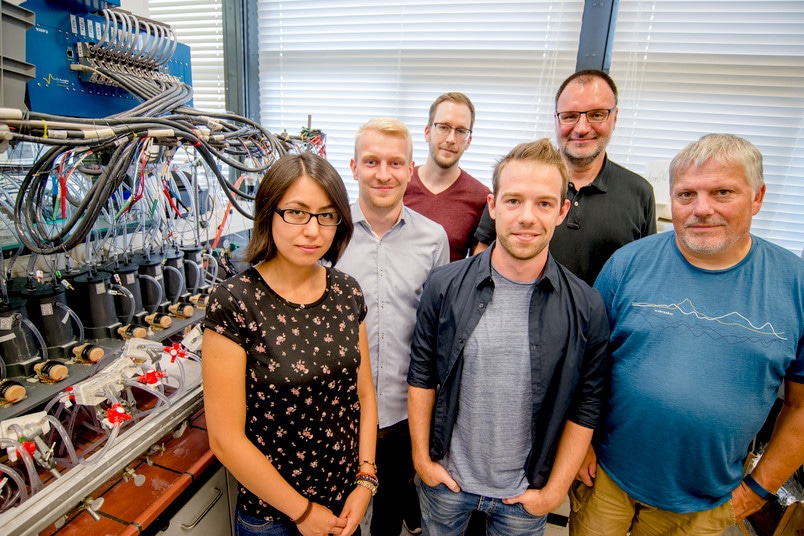Jul 27 2018
Chemists at Ruhr-Universität Bochum (RUB) have created a new, low-cost catalyst for plastic manufacture. It converts a biorefinery product into a starting material for the synthesis of plastics, which could signify a sustainable substitute to prevalent PET. Simultaneously, the potential energy source hydrogen can also be developed during the reaction. During the research, the team surrounding Dr Stefan Barwe and Prof Dr Wolfgang Schuhmann from the Bochum-based Centre for Electrochemical Sciences partnered with the RUB Laboratory of Industrial Chemistry under the leadership of Prof Dr Martin Muhler. The scientists explain their work in the journal Angewandte Chemie dated 9th July 2018.
 The Bochum team: Dulce Morales, Steffen Cychy, Stefan Barwe, Dennis Hiltrop, Martin Muhler and Wolfgang Schuhmann (from left) © RUB, Marquard
The Bochum team: Dulce Morales, Steffen Cychy, Stefan Barwe, Dennis Hiltrop, Martin Muhler and Wolfgang Schuhmann (from left) © RUB, Marquard
“We could take a big step towards a sustainable chemicals industry if we did not use crude oil as the starting material, but rather biomass that is not used as a foodstuff,” says Wolfgang Schuhmann.
An alternative to PET
In their research, the Bochum-based researchers introduce a nickel boride catalyst which—as it does not contain any expensive metals - is easily available and affordable compared with a number of other catalysts. It can turn the biorefinery product HMF (5-hydroxymethyl-furfural) into FDCA (2, 5-furandicarboxylic acid).
"FDCA is interesting for the industry because it can be processed into polyesters,” explains Stefan Barwe. “PEF, an alternative to PET, can thus be produced – and all of this is based on renewable raw materials, i.e. plants.”
Less energy consumption thanks to hydrogen production
In the tests done by the Bochum-based team, the catalyst converted 98.5% of the starting material HMF into FDCA in half an hour; no waste products are developed. “We have also designed the catalyst in such a way that it is effective under the same conditions under which hydrogen production is also successful,” Stefan Barwe describes an additional benefit of the development. The scientists were thus also able to employ the starting material to synthesize hydrogen as the potential energy source. Hydrogen is typically obtained from water using electrolysis, which also creates oxygen. The principally energy-consuming reaction step, oxygen evolution, was eliminated when the scientists connected hydrogen evolution and FDCA production.
Reaction mechanism clarified
The team also elucidated the reaction step-by-step using electrochemical techniques and infrared spectroscopy. For the first time, the chemists succeeded in tracking in real time which intermediate products change HMF into FDCA.
Funding
The German Research Foundation supported the research as part of the cluster of excellence Ruhr Explores Solvation (EXC 1069) and the Collaborative Research Centre/Transregio 247. Dulce Morales, one of the authors, received funding from the German Academic Exchange Service and from Consejo Nacional de Ciencia y Tecnología.